
Author: Tanay Ved Source: Coin Metrics Translation: Shan Oppa, Bitchain Vision
Key points:
-
The treasury of digital assets with ETH as the core is expanding rapidly and has accumulated in just two months.2.2 million ETH(accounting for 1.8% of supply), causing an imbalance in supply and demand.
-
These treasuries adopt an active on-chain strategy, planning to deploy funds through staking and DeFi, supporting cybersecurity and liquidity while improving returns.
-
Although it is still in the accumulation stage, more on-chain participation may not only enhance Ethereum’s liquidity and security, but also increase its exposure to corporate capital management risks.
The rise of digital assets treasury
Digital Asset Treasuries refers to listed companies that hold crypto assets such as BTC or ETH on the company’s balance sheet, which is becoming a new channel for market entry.
The launch of spot ETFs in 2024 has unleashed the demand for investors who previously could not hold BTC and ETH through direct custody.Similarly, the digital asset treasury allows investors to gain exposure to these assets and their ecosystems through listed company stocks and can strategically raise and deploy funds.
We have previously analyzed Michael Saylor’s strategy manual – raising funds through equity and convertible bond financing, with a total of more than628,000 BTC(2.9% of the Bitcoin supply).Globally, companies from Marathon Digital to Metaplanet in Japan have followed suit and provided shareholders with amplified (leveraged) BTC exposure.
Today, this model is expanding to other ecosystems, and a group of companies are scrambling to include ETH into their corporate treasury.
Although the goal of increasing shareholder exposure to target assets is the same, the ETH treasury is fundamentally different from the BTC treasury – the ETH treasury can participate in the staking and DeFi ecosystem of Ethereum, thereby leveraging ETH native income and efficiently deploying funds on the chain.This article will explore the impact of ETH Treasury on Ethereum supply dynamics and look forward to the potential network effects of these large institutions entering the chain.
Supply News: Fight for 5% Market Supply
Since July this year, the treasury of Ethereum digital assets has accumulated2.2 million ETH, accounting for about 1.8% of the current supply.Currently, 5 major companies raise funds and deploy through equity financing (such as public offerings or PIPE private placements) to increase their holdings value:
-
Bitmine Immersion Technologies: 1.15 million ETH (approximately US$4.8 billion)
-
SharpLink Gaming: 5.21,000 ETH (approximately US$2.2 billion)
-
The Ether Machine: 345,000 ETH (about 1.4 billion US dollars)
-
Bit Digital: 120,000 ETH (approximately US$503 million)
-
BTCS Inc.: 70,000 ETH (approximately US$293 million)
in,Bitmine Immersion TechnologiesIt is currently the largest corporate ETH holder, accounting for 0.95% of the supply, and its holdings are rapidly approaching its public statement.Hold circulating supply 5%goal.As market conditions change, these companies are rapidly building reserves at relatively low costs, and the competition for acquisitions is becoming increasingly fierce.
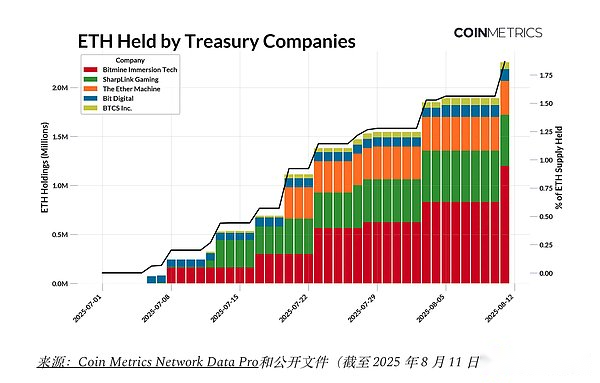
This trend is more prominent when compared with Ethereum’s issuance mechanism.Ethereum isProof of Stake (PoS)In mode, new ETH is issued to validators, and some transaction fees are destroyed, so net issuance may fluctuate between deflation and inflation.
Since the “merger” in September 2022, Ethereum has been issued2.44 million ETH,destroy1.98 million ETH, net supply growth454,300 ETH.Since July alone, ETH Treasury has accumulated2.2 million ETH, far exceeding the net new issuance volume in the same period.
In contrast, Bitcoin’s total cap and halving mechanism will continue to compress new supply, while Ethereum’s supply is dynamic and currently in an inflationary state.Given that ETH’s market value is approximately BTC1/4.5, the scale and speed of this round of demand are particularly eye-catching.
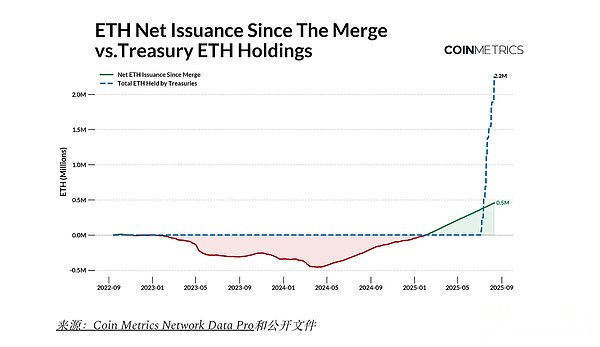
This supply and demand imbalance is even more obvious when taking into account the inflow of funds from Ethereum ETFs – and the inflow of ETFs has also accelerated in the past few months.Overall, these investment tools are steadily absorbing Ethereum107.2 millionCirculation supply (market available supply), which does not include consensus layer pledge29% ETHand other smart contracts held8.9% ETH.Therefore, if the continued accumulation of treasury and ETFs continues, the sensitivity of price to new demand will be amplified.
Ecological impact: pledge, DeFi and on-chain activities
While most ETH treasury is still in the accumulation stage, some funds may eventually flow into the chain.By accessing Ethereum’s staking and DeFi infrastructure, these companies aim to increase risk-adjusted returns and allow assets to be effectively utilized – a stark contrast to the more passive holding of Bitcoin’s treasury.This transition has begun, for exampleSharpLink GamingMost of its positions have been pledged.BTCS Inc.useRocket Poolto generate income,The Ether MachineandETHZillaCompanies such as the company are preparing to carry out on-chain management more actively.
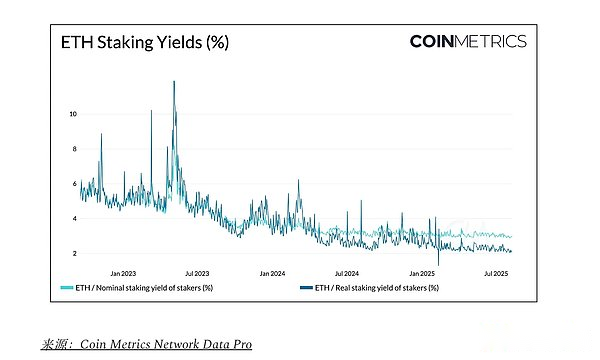
Ethereum is currently provided through staking rewardsNominal annualization 2.95%,Actual annualization 2.15% (after inflation adjustment)The benefits are used to ensure network security.This allows Treasury companies to obtain stable cash flow income while the price of their underlying assets rises.For example, suppose that the Treasury company currently holds2.2 million ETHThere is30%At the current nominal rate of return of approximately 3%,4,000 USD/pcThe price is pledged, and the annual income can reach about$79 million.Although the increase in pledged funds may compress the rate of return, the impact is relatively small, because the reward rate of Ethereum will gradually decrease with the increase of the total pledge.
Enterprise treasury usually participates in pledge in two ways:Run your own verification node orUse liquidity staking agreement(The US SEC has made it clear that this method is not considered a securities)
The second way allows enterprises to passLido, Coinbase, or Rocket Pooland other third parties to pledge and obtain tradable “liquidity certificate tokens” in return.
These tokens (such as Lido’sstETH) Although it brings additional risks, it is widely used as collateral loans in DeFi, or to obtain additional benefits above the benchmark staking APY while improving capital efficiency.
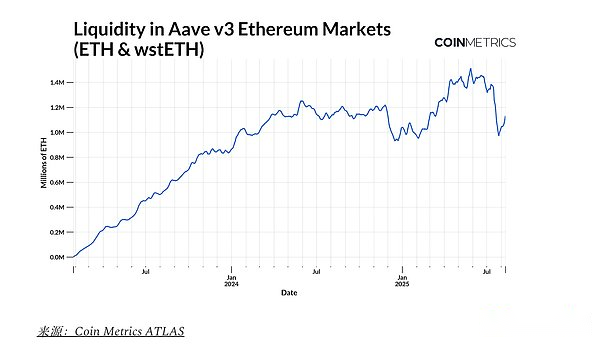
byAave v3For example, ETH and liquid staking tokens (such as wstETH) form a deep liquidity pool (the amount of assets that have been supplied and lent out), and the scale has reached approximately1.1 million ETH, the addition of the treasury can further enhance the liquidity pool and improve market liquidity while compounding returns.
Although the current daily transaction count on the Ethereum mainnet has reached a record high (1.7 million to 1.9 million transactions per day), but the total handling fee is still close to the long-term low – the recentGas cap increaseandBlob capacity expansionRelieve congestion and transfer some activity to L2.If treasury funds flow into the chain on a large scale, high-value transactions will increase overall block space demand and fee income on Ethereum L1, which may form a positive cycle—Treasury activities → Improved liquidity → Increased on-chain use → Further active ecology.
Linking corporate treasury performance with on-chain health
As the listed ETH treasury continues to expand its on-chain layout, their financial performance is increasingly likely to affect the long-term network health of Ethereum, directly linking off-chain business operations results with potential on-chain effects.Large-scale and long-term holdings can reduce circulation and supply, enhance credibility, and deepen on-chain liquidity, but excessive concentration of holding coins, excessive leverage ratio and operational risks also mean that fluctuations at the enterprise level may be transmitted to the network.
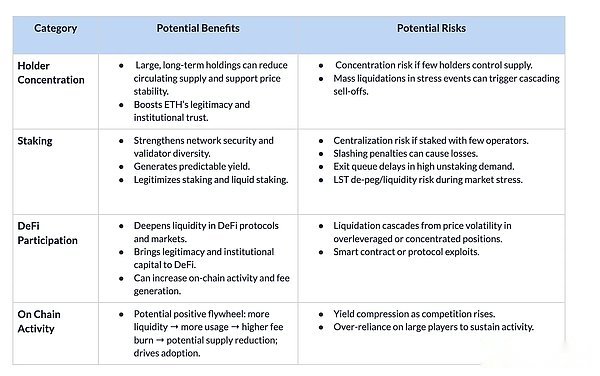
Although these are network-level considerations, the corporate treasury itself is still affected by market forces and investor sentiment.A healthy balance sheet and sustained investor confidence can enable the treasury to expand its holdings and increase participation; conversely, a sharp decline in the underlying price, tightening of liquidity or excessive leverage may lead to ETH selling or reduced on-chain activity.
Indicators linked to Treasury performance
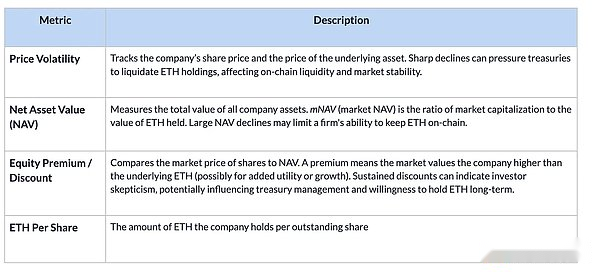
By simultaneously tracking the impact at the network level and the financial health of these companies, market participants can better predict how corporate treasury behavior will affect Ethereum’s supply dynamics and overall network health.
in conclusion
Enterprise ETH The rapid rise of Treasury demonstrates Ethereum asReserve assetsandOn-chain revenue sourcesdouble attraction.Their growing presence may deepen liquidity and enhance network activity, but it also brings risks related to leverage, financing and capital management.From stock price performance to debt obligations, off-chain pressure may be quickly transmitted to the chain as the two become more closely linked.Therefore, trackingBalance sheet health statusandOn-chain activities, will be the key to understanding the impact of these institutionalized carriers in the process of scale expansion.







